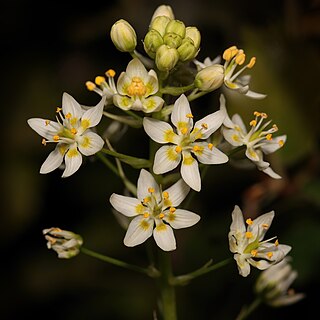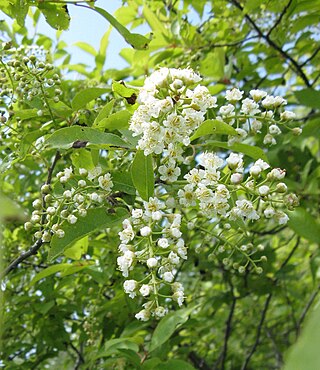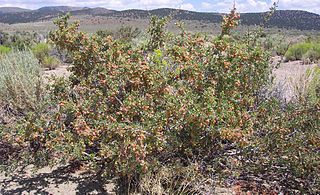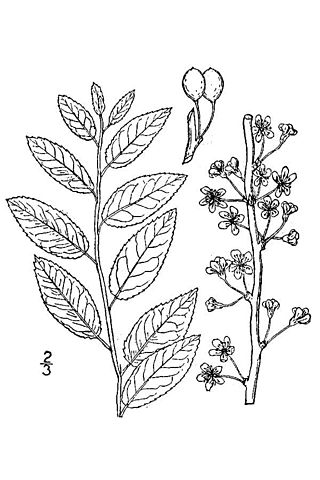
Toxicoscordion fremontii, known as the common star lily or Frémont's deathcamas or star zigadene, is an attractive wildflower found on grassy or woody slopes, or rocky outcrops, in many lower-lying regions of California, southwestern Oregon, and northern Baja California.

Prunus virginiana, commonly called bitter-berry, chokecherry, Virginia bird cherry, and western chokecherry, is a species of bird cherry native to North America.

Prunus andersonii is a species of shrub in the rose family, part of the same genus as the peach, cherry, and almond. Its common names include desert peach and desert almond. It is native to eastern California and western Nevada, where it grows in forests and scrub in desert and mountains. It was named after Charles Lewis Anderson by Asa Gray.

Prunus ilicifolia is native to the chaparral areas of coastal California, Baja California, and Baja California Sur. as well as the desert chaparral areas of the Mojave desert.

Atriplex confertifolia, the shadscale or spiny saltbush, is a species of evergreen shrub in the family Amaranthaceae, which is native to the western United States and northern Mexico.

Mammillaria dioica, also called the strawberry cactus, California fishhook cactus, strawberry pincushion or fishhook cactus, is a cactus species of the genus Mammillaria. Its common name in Spanish is biznaga llavina.

Prunus subcordata, known by the common names Klamath plum, Oregon plum, Pacific plum and Sierra plum, is a member of the genus Prunus, native to the western United States, especially California and Oregon.

Chaenactis is a genus of plants in the family Asteraceae which are known generally as pincushions and dustymaidens.

Ferocactus cylindraceus is a species of barrel cactus which is known by several common names, including California barrel cactus, Desert barrel cactus, compass barrel cactus, and miner's compass. It was first described by George Engelmann in 1853.
Malperia is a North American plant genus in the tribe Eupatorieae within the family Asteraceae.

Amphipappus is a North American genus in the family Asteraceae. It is native to desert regions of the southwestern United States, in southern California, southern Nevada, Arizona, and southeastern Utah.

Chaenactis fremontii, with the common names Frémont's pincushion and desert pincushion, is a species of annual wildflower in the daisy family. Both the latter common name, and the specific epithet are chosen in honor of John C. Frémont.
Helianthus niveus is a species of sunflower known by the common names showy sunflower and snowy sunflower. It is native to northern Mexico and the Southwestern United States.
Syntrichopappus is a genus of flowering plants in the family Asteraceae, found in the Southwestern United States and northern Mexico, including Baja California. It is a member of the Heliantheae alliance of the Asteraceae. There are two species. Common names include xerasid and Frémont's-gold.

Populus fremontii, commonly known as Frémont's cottonwood, is a cottonwood native to riparian zones of the Southwestern United States and northern through central Mexico. It is one of three species in Populus sect. Aigeiros. The tree was named after 19th-century American explorer and pathfinder John C. Frémont.

Quercus turbinella is a North American species of oak known by the common names shruboak, turbinella oak, shrub live oak, and gray oak. It is native to Arizona, California, New Mexico, Utah, Colorado, and Nevada in the western United States. It also occurs in northern Mexico.

Prunus caroliniana, known as the Carolina laurelcherry, Carolina cherry laurel, Carolina cherry, or Cherry laurel, is a small evergreen flowering tree native to the lowlands of Southeastern United States, from North Carolina south to Florida and westward to central Texas. The species also has escaped into the wild in a few places in California.

Prunus angustifolia, known commonly as Chickasaw plum, Cherokee plum, Florida sand plum, sandhill plum, or sand plum, is a North American species of plum-bearing tree. It was originally cultivated by Native Americans before the arrival of Europeans. The species' name angustifolia refers to its narrow leaves. It became the official state fruit of Kansas in 2022.

Prunus gracilis, called the Oklahoma plum, sour plum, and sand plum, is a species of Prunus native to the south-central United States.

John C. Frémont (1813–1890) was an American explorer of the West during the 1840s and 1850s, popularly known as the Pathfinder, while serving in the U.S. military and as a private citizen. His first two published federal expeditions launched a mass emigration into the American West producing maps and reliable reports for settlers to read and follow. In the process of botanical nomenclature, Frémont received many eponyms in his honor and for his work as a botanist. His genus name eponym is Fremontodendron, while his species eponym is fremontii. Frémont went on a total of five expeditions; the first three were federally sponsored while Frémont served as a military officer. On these expeditions he was guided by mountain man Kit Carson. Frémont's fourth and fifth expeditions were privately sponsored. Although Frémont's life was controversial, he was considered an American hero. Frémont's published works, co-authored by his wife Jessie, could either be read scientifically or as adventure stories, capturing the public's attention, and creating enthusiasm for Westward migration.



















